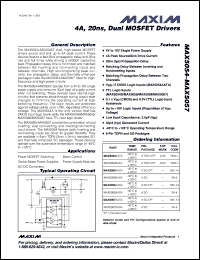|
|

|
|
| Partname: | MAX5057AASA+T |
| Description: | 4A, 20ns, Dual MOSFET Drivers. Lead-free |
| Manufacturer: | Maxim Integrated Products |
| Datasheet: | PDF (529K).
Click here to download *) |
The MAX5054MAX5057 dual, high-speed MOSFET drivers source and sink up to 4A peak current. These devices feature a fast 20ns propagation delay and 20ns rise and fall times while driving a 5000pF capacitive load. Propagation delay time is minimized and matched between the inverting and noninverting inputs and between channels. High sourcing/sinking peak currents, low propagation delay, and thermally enhanced packages make the MAX5054MAX5057 ideal for highfrequency and high-power circuits. The MAX5054MAX5057 operate from a 4V to 15V single power supply and consume 40A (typ) of supply current when not switching. These devices have internal logic circuitry that prevents shoot-through during output state changes to minimize the operating current at high switching frequency. The logic inputs are protected against voltage spikes up to +18V, regardless of the VDD voltage. The MAX5054A is the only version that has CMOS input logic levels while the MAX5054B/MAX5055/ MAX5056/MAX5057 have TTL input logic levels. The MAX5055MAX5057 provide the combination of dual inverting, dual noninverting, and inverting/noninverting input drivers. The MAX5054 feature both inverting and noninverting inputs per driver for greater flexibility. They are available in 8-pin TDFN (3mm x 3mm), standard SO, and thermally enhanced SO packages. These devices operate over the automotive temperature range of -40C to +125C. |
|

Click here to download MAX5057AASA+T Datasheet*) |
 |
| *)Datasheets downloading from ChipDocs is only for our members (paid service). REGISTER NOW for your membership. |
|
|
|

